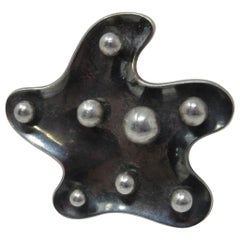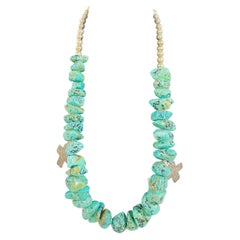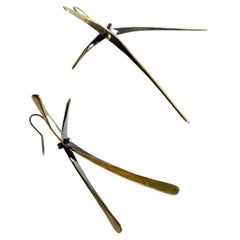Mainly Art Vintage Modern Furniture Collectible Jewelry
2
to
2
2
2
2
2
2
2
2
2
2
2
1
1
1
Sigfredo Pineda Sigi Mid Century Sterling Brooch Pendent
By Sigi Pineda
Located in Cincinnati, OH
A well crafted sterling silver brooch pendent with amoeba shaped design having 8 silver balls of varying sizes to the front. The back round has been oxidized by the artist and the ed...
Category
Mid-20th Century Mexican Mid-Century Modern Collectible Jewelry
Materials
Sterling Silver
Early Mid Century Sterling / Pearl Pin or Necklace by Ed Levin
Located in Cincinnati, OH
A very well artisan crafted Mid-Century Modern 925 sterling silver concave pin back or hanging necklace in the brooch pendent style giving the wearer two choices in wear ability. The...
Category
Mid-20th Century American Mid-Century Modern Collectible Jewelry
Materials
Sterling Silver
Related Items
Navajo Turquoise and Pearls Necklace with Sterling Silver Cross Pendants
Located in Plainview, NY
A vintage Native American Navajo turquoise stone necklace with authentic 26 pearls and two carved cross pendants in sterling silver. The necklace is attributed to the Jewelry designer T-Foree.
This vintage necklace will make a statement and is a collectible piece.
To the Navajo tribe, the color turquoise represents happiness, luck, and health. ... Black, white, blue, and green were the colors within the turquoise stone which represent the colors of the natural world. A horseshoe-shaped symbol or a symbol called “Naja” appeared often in tradition Navajo jewelry...
Category
20th Century American Tribal Collectible Jewelry
Materials
Stone, Sterling Silver
Rare Mid-Century Modernist Sterling Silver Petal Earrings By Art Smith
By Art Smith
Located in Brooklyn, US
Exceptional and pair of kinetic earrings designed by Greenwich Village modernist jeweler Art Smith in the 1950's. Smith is considered a master jewelers during the modernist movement ...
Category
Mid-20th Century American Mid-Century Modern Collectible Jewelry
Materials
Brass
Rare 19th Century English Tunbridgeware Hair Pin or Slide
Located in Dallas, TX
Presenting an absolutely gorgeous and extremely unique and rare 19th century British Tunbridgeware hair pin/bobbin or slide.
This slide is unlike any of it’s kind we have seen before…. it is a very rare survivor !
From circa 1860–1880.
Made of walnut with gorgeous marquetry inlay on the entirety of the front with classic Tunbridgeware micro-mosaic all over the front. The rear is walnut.
The marquetry inlay appears to be various different woods, namely, maple, walnut and satinwood.
Would have been worn in a Lady’s hair bun with the micro-mosaic facing forward.
This would have belonged to a very elegant lady in the mid to late 19th century.
Tunbridge ware is a form of decoratively inlaid woodwork, typically in the form of boxes, that is characteristic of Tonbridge and the spa town of Royal Tunbridge Wells in Kent in the 18th and 19th centuries. The decoration typically consists of a mosaic of many very small pieces of different coloured woods that form a pictorial vignette. Shaped rods and slivers of wood were first carefully glued together, then cut into many thin slices of identical pictorial veneer with a fine saw. Elaborately striped and feathered bandings for framing were pre-formed in a similar fashion.
There is a collection of Tunbridge ware in the Tunbridge Wells Museum and Art Gallery in Tunbridge Wells.
The famous makers of Tunbridge ware were in the Tunbridge Wells area of Kent; their most notable work was from circa 1830-1900.
Early makers of Tunbridge ware, in Tunbridge Wells in the mid-18th century, were the Burrows family, and Fenner and Co. In the 19th century, around 1830, James Burrows invented a technique of creating mosaics from wooden tesserae. Henry Hollamby, apprenticed to the Burrows family, set up on his own in 1842 and became an important manufacturer of Tunbridge ware, employing about 40 people.
Edmund Nye (1797–1863) and his father took over the Fenner company when William Fenner retired in 1840, after 30 years in partnership with him. Thomas Barton (1819–1903), previously apprenticed at the Wise factory, joined the Nyes in 1836, and worked as Nye’s designer; he took over the business in 1863 and continued there until his death.
In Tonbridge (near to Tunbridge Wells), George Wise (1703–1779) is known to have had a business in 1746. It continued with his son Thomas, and Thomas’s nephew George (1779–1869), who took over in 1806. In its early years the company made articles such as workboxes and tea caddies with prints of popular views; later items had pictures created from mosaics. Their workshop in Tonbridge, Wise’s Tunbridge Ware Manufactory, was next to the Big Bridge over the Medway; the building was demolished in 1886 to widen the approach to the bridge.
Tunbridge ware became popular with visitors to the spa town of Tunbridge Wells, who bought them as souvenirs and gifts. Articles included cribbage boards, paperweights, writing slopes, snuffboxes and glove boxes.
At the Great Exhibition of 1851, Tunbridge ware by Edmund Nye, Robert Russell and Henry Hollamby was shown; Edmund Nye received a commendation from the judges for his work. He exhibited a table depicting a mosaic of a ship at sea; 110,800 tesserae were used in making the picture.
The manufacturers of Tunbridge ware were cottage industries, and they were no more than nine in Tunbridge Wells and one in Tonbridge. The number declined in the 1880s; competent craftsmen were hard to find, and public tastes changed. After the death of Thomas Barton in 1903 the only surviving firm was Boyce, Brown and Kemp, which closed in 1927.
Marquetry was an old technique which was continued by Nye and Barton to create images such as birds or butterflies.
‘Green Oak’ as caused by the fungus Chlorociboria aeruginascens.
Stickware and half-square mosaic was invented by James Burrows in about 1830: a bunch of wooden sticks of different colours, each having triangular or diamond-shaped cross section, were tightly glued together; in the case of stickware, the resulting block was dried, then turned to form an article such as the base of a pincushion. For half-square mosaic, thin slices were taken from the composite block, and applied to a surface.[1][2][4]
Tesselated mosaic, was a development by James Burrows of half-square mosaic; it was adopted by George Wise and Edmund Nye. Minute tesserae were used to form a wide variety of geometric and pictorial designs.
Many sorts of wood were used for the various colours; about 40 were in regular use. Only natural colors were used; green was provided by “green oak”, produced by the action of fungus on fallen oak. Designs for articles were often taken from designs of Berlin wool work.
Category
Antique Late 19th Century English High Victorian Collectible Jewelry
Materials
Satinwood, Walnut
Mid-Century Modern Sterling Silver Thermometer by Tiffany & Co.
By Tiffany & Co.
Located in New York, NY
Mid-Century Modern-Period, sterling silver thermometer in working condition, Tiffany and Company, New York, circa 1950s. Works are made by...
Category
Vintage 1950s American Mid-Century Modern Sterling Silver
Materials
Metal, Sterling Silver
Mid-Century Navajo Silversmith T. K. Turquoise and Silver Brooch
Located in Point Richmond, CA
Mid-century Navajo silversmith T. K. Turquoise and silver brooch
A large gorgeous old turquoise stone set in an almost heart-shaped broo...
Category
Mid-20th Century American Native American Tribal Art
Materials
Silver
Early to Mid-20th Century Pendant Silver Necklace, Yemen
Located in Point Richmond, CA
Early to mid-20th century pendant silver necklace, Yemen
This pendant necklace has an interesting center medallion of transparent red glass over a faceted sheet of silver, which g...
Category
Early 20th Century Yemeni Tribal Tribal Art
Materials
Silver
Hans Hansen Sterling Bracelet Bangle Danish Geometric, Mid-Century Modern
By Hans Hansen, Georg Jensen
Located in Hyattsville, MD
A rare and well loved Minimalist Scandinavian 1970s modernist sterling silver hexagonal bangle. A seldom offered design, versatile, and comfortable with...
Category
Vintage 1970s Danish Scandinavian Modern Collectible Jewelry
Materials
Sterling Silver
H 0.31 in W 2.87 in D 2.87 in
Indigenous Sheyka Sterling Silver and Inlaid Figural Rabbit Brooch or Pendant
By Native American Art
Located in Hamilton, Ontario
This Zuni Indigenous American sterling silver and inlaid gemstone figural rabbit brooch or pendant was made by Porfillo and Ann Sheyka. The piece was handmade in most likely the late...
Category
Mid-20th Century American Mid-Century Modern Collectible Jewelry
Materials
Multi-gemstone, Sterling Silver
H 1.5 in W 2 in D 0.25 in
Early 20th Century Italian Sterling Silver Chalice
Located in Casale Monferrato, IT
Italian sterling silver Chalice finely embossed and chiselled 800 punch at the base. cup in golden bath. Excellent condition with its original packaging.
Category
Vintage 1930s Italian Sterling Silver
Materials
Silver
Mid-20th Century Antoñio Pineda Silver and Moonstone Brooch, Taxco, Mexico
By Antoñio Pineda
Located in Point Richmond, CA
Mid-20th Century Antoñio Pineda (1919-2009) Silver and Moonstone Brooch, Taxco, Mexico
This beautifully crafted silver brooch contains eight oval-cut moonstone cabochons set in a curved row above six stylized leaves. The marks on the back of the pin are: TAXCO SILVER BY TONO, Made in Mexico, with a 17 eagle stamp...
Category
Mid-20th Century Mexican Modern Tribal Art
Materials
Silver
H 1 in W 3.75 in D 0.88 in
MId-Century Modern Sterling Silver-Mounted Honeywell Barometer
By Baldwin & Miller
Located in New York, NY
Mid-Century Modern, sterling silver-mounted Honeywell barometer, Baldwin and Miller Co., Indianapolis, Indiana, Ca. 1950's. Barometer mechanism itself is made by the Honeywell Compan...
Category
Vintage 1950s Mid-Century Modern Scientific Instruments
Materials
Metal, Sterling Silver
Mid Century Modernist Sterling Collar Necklace
Located in Mt Kisco, NY
Amazing Artisan Crafted Sterling Silver Necklace. Free Form Design Hangs in a splayed fashion on the neck and chest.
Marked Sterling
Category



